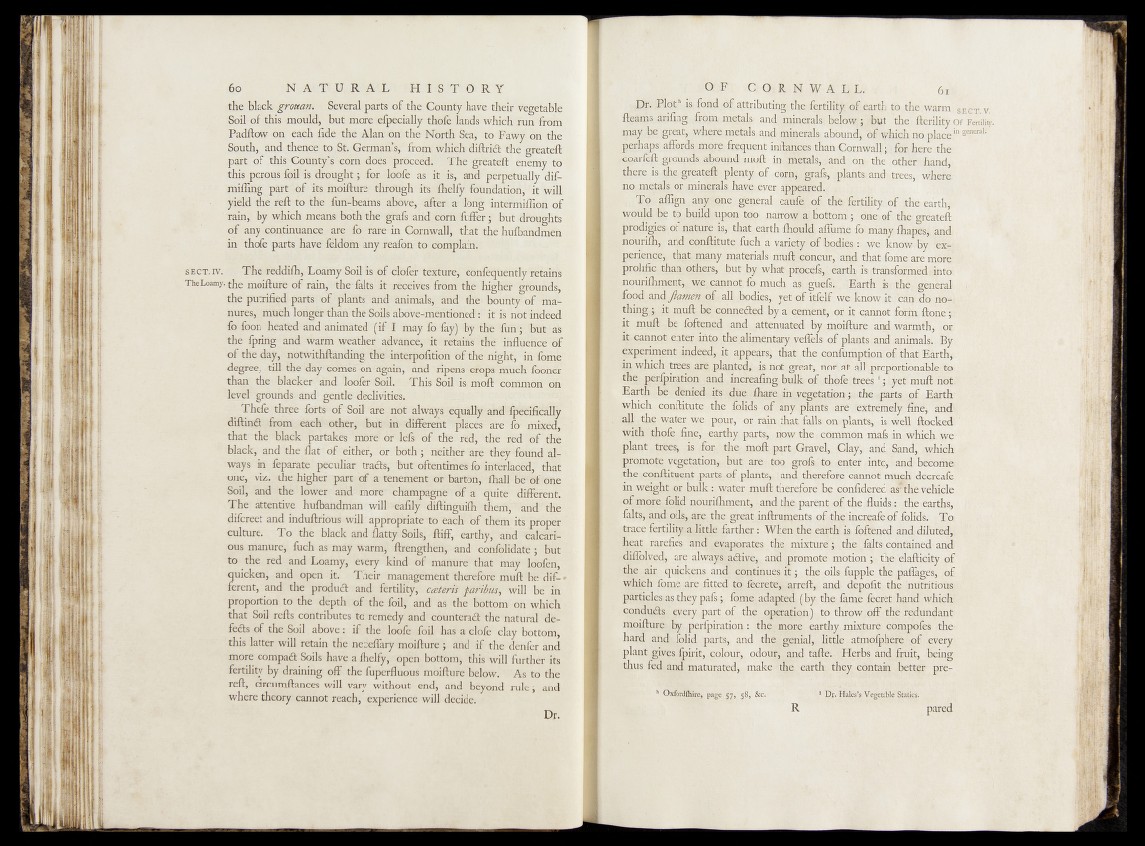
the black grouan. Several parts d£ the County have, thdir^gëtaBle
Soil of -this -mould, but more^efpedaHy thofe lands which'‘run from
Padftow on’ each fide the Alan ón"thövNbrth Seay to 'Fav^^on the
South, and thencejtp.Si. Germams,' from^hièfcHiftri^: greateft
.part' of this County’sJ corn does ^prbceèd/ " The' greateït enemy to
this jporous fbiHs drought; fopdoofe as itf-is, and perpetually dif-
mifimg part of its moifture through itfcHÉtelfy1 foundation, it will
yield the réft to the lun-beams above, after a‘ long tinterniiflion of
tain, by which means both the-grifs and corn fuffer f but.droughts
o f any continuance are fo rare in Cornwall, that thé hufbandmén
in thole parts have feldom any reafon to complain.
s e c t . iv. 5 The-reddifh, Loamy Soil-is of dofer texture, ^nlè^iêntiyYédaiifs
TheLoamy. the moifture o f rain, the-felts it receives from the higher grounds,
the putrified parts of plants and animals, and the> Taouhtpbr^:^-
nures, much longer than the Soilshïbölre-hfentionedit'iinod ‘indeed
lb foon heated and animated ( if I may lb fey) Hgy thé Jlun?;: !bnt afc
the fpring and -warm weather ^ a d # M f e g i t ^ f ■
o f the day, notwithftan ding the- interpolation tibihe night, inTemeT
degree, till the day*comes'on-again, and ripens e lb^Mudr fbbHer
than the blacker and loofer‘Soil.f
level grounds and geritie declivities,
Thefe three forts o f Soil are~not always equally an$s$pÉKff&ly
diftinö froim each other, but in-different p ace s '^^ ^^ mixéd',
that-the 'black partakes “fliöfé! oruefè of - tIforfSk’ the ^èd ;bfrthe
black, and the flat of either, or both; neither- are !hëy-f©|ind i S
ways in feparate peculiar pads, but oftentimes ‘folht^lacdd^ that
f^ h ig h e r part of a tenement qrlJBSBm/'fhall Bè^dPone
Soil, and the lower and mdfei_ bhaffipagne~'(lf a''':^ifë^' d,iffëfèrif.
The attentive hulbandman will ‘-ealily diftinguifh 'them'"'and“' the
difcreet and induftrious will appropriate to each of them its proper
culture. To the black and Hatty Soils, ftiff, earthy, and calcarr-
ous manure, fuch as may warm, ftrengthen, and confolidafe; but
to the red and Loamy, every kind of manure that 'may loofen,
quicken, and open it. Their management therefore mull be di£- •
ferent, and the product and fertility, ctètérïS .fdiïèüs, will be in
proportion to the depth of the foil, and as the bottom on which
that Soil refts contributes to remedy and counteract the natural defects
of the Soil above: if the loole foil has a dole clay bottom,
this latter will retain the needfery moifture j and if the denier and
more compact Soils have a Ihelfy, Open bottom, this will furthèr its
fertility by draining off the luperfluous moifture below. As to the
reft, circumftances will vary without end, and beyond rule; and
where theory cannot reach, experience will decide.
Dr.
Dr fop'd^l 4|tributijjg| the,Ter,tih'f:y o f .earth to the .warm sect.v
fteams; arifing from metals antfj^ineralsr below;; ;but the, fterility Of Fertility,
may bepgreat, where metals minerals abound,’ of which no place'11 §eneral‘
ESrJ},aBsl?ff0^i®i|g^l^u§nt inftances than Cornwall I , for, here the
(qgarfeft grounds, afequpd niq(t indmej:als, rand/on,- the other'* hand,
Aere i s ^ f ^W ^ ^ p j ^ a t ^ o f cor^&^graf, .plants’; and.; trees, where
no metalf dr .mittsials ha^j^efetk. a j^ d red. t
j . tal cauf^^th^'^tghyhof^the earthy
‘wouf e bp tq buil^upan too narrbvj| ^ bot&6mK dj|ie,Qf the* greateft
h, t h a t ^ t l i IhpuM affirm,e/ot maay fhape<s|
Souriffi^, arMt.e|nftitute fuch* a varie&W'^qdies : ^weyknotelry
that^nany materials muipeoncur, ar|d> that foffie are more?
but by^mt'ip^qcbls,^ earth? i's- ‘transformed
i t q t i J ^ ^ j^ ^ e a n no^ fe muck, cth' ddtfhh ■ hpn^cl.
itii# ^^kntiw^it-fcatt'-do no?4--
t h in g s itj rquft» be ^nrjefledVby, a ' cement, .oi^lt qannot form f t n n P ^ f
jt muft^be foftenC^ tmd^atjenuated by„mmlhyte .andywarmth, 4o$ ^
,;1V,cannot enter^intafrhe^alimentat^veffd» eff plains* and ^Jiimals, ,%>
Jpdeed, it appears, that ,the,c©nfamptiomo£that Tkrthy
in which trees are planted, ismot^grgat;, norfat all proportionable,^to
the perfpiratiom}and ;mcEealing bulk offith©fe;trees1 ,* hyebmuft not»
EaitK vK 'denied its due. lhare, in^yegftatipn. ^»tthe parts Ko£ ,.Earth‘ ’
which, ^ cqnftitute the lolids or ^^plants are 'extremely nne, and*.
pour, or rain that,* falls omplantSj^i&jWell flocked'
with ^ofe fine, earthy parts, , now the T common mafs, in which, isve' 5
plant, rtqes-, is ,for^ the moft part .Gravely Clay, and. Sand, which
promote vegetation,, but are- foq grolk tq, venter <into,yand become^
the conftituent parts of plants, and therefore cannot much decreafe
in weight pr bu lk : water muft therefore be confidered-, a®he vehicle
nourilhment, and the, parent .of the .-fluids,: the earths, I
felts, and oils, are^the great inftruments of dlfc inaj^afe of Iqlids. To
grace fertility a little farther: When-the earth "rghlqftfened and; diluted,; ‘
heat rarefies and .evaporates thq-, mixturd; ^the. felt»>;contained and'
diflblved,,.aje,alway^dive, ani|^promote motion ; > the elafticity of
the air quickens and continues i t ; the oils fupple the p.affages, of
whiph foi?i^are)fttt^|tp- jCp^^^greiElv and dppofit„the , nufritious'
particles as tdiey pafs; fome adapted (by the, feme fqc^et hand which
conducts, every part of the operationTto throw.off the redundant
moifture -;by?fperlpiration: the; ii^>re earthy.mixture compofes the-
hard and; fohd parts, and the-, genial, little atmofphere yof eveiy
plant gives fpirit, colour, odou^fjmhd tafte. Herbs and frfiit, being
thus fed and maturated, makelthe earth they contain better prepared
h Oxford {hire, page S7> 58, &c,
R
1 Dr. Hales’s Vegetable Statics.